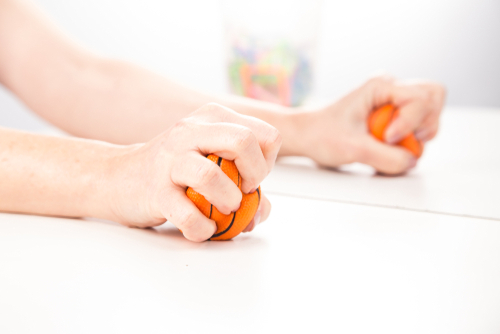Mirror therapy has many implications for therapy and can be used to treat many diagnoses that commonly involve the upper extremity. These include some of the Neuro Conditions we highlighted last week including, Stroke and Focal Hand Dystonia. Btw, you can download a mirror therapy exercises pdf here for free.

How long should the patient perform mirror therapy exercises? Should there be a sequence of routines prior to performing mirror therapy? There is no simple answer and a wide range of dosing information along with frequency and duration for performing mirror box therapy.
Despite the variety in rehab regimes for mirror therapy, the majority of them have demonstrated positive effects. From the studies, a general protocol was developed know as the St. Gallen MT Protocol. The St. Gallen MT Protocol was tested on 52 patients. Of those, 42 out of 52 patients showed a reduction in pain, improved function, and no phantom sensations.
Here are some key highlights from the studies and the St. Gallen MT Protocol.
Keys to using mirror therapy in treatment
- Explain clearly how mirror therapy works, the patient must have the buy-in
- Perform mirror therapy in a quiet environment
- Set up a home program using mirror therapy (mirror therapy boxes) can be made out of cardboard boxes by gluing a handheld mirror on the side or you can fabricate a wooden one for under $15 (see below video below).
- Utilize a patient log for tracking mirror therapy exercises.
- Review patient log at follow-up therapy visits
Duration
- Home Program must be performed 5-6x/day,
- Each session should be no longer than 5-10 minutes
- Adapt exercise based on diagnosis
Grunert-Pluss, N., Hugschmid, U., & Santschi, L. (2008). Mirror therapy in hand rehabilitation: A review of the literature, the st gallen protocol for mirror therapy and evaluation of a case series of 52 patients, 13, 1, 4-11.
Supply list for making a mirror box (mirror therapy handout)
https://www.handtherapyacademy.com/wp-content/uploads/2019/06/mirror-box-material-list-.pdf
Video on how to make a mirror box
2 Comments
Leave a Comment
More To Read
Therapeutic Exercise vs Therapeutic Activity
What is the difference between therapeutic exercise vs therapeutic activity? Therapeutic exercise is billed as 97110 and Therapeutic activity is billed as 97530. Both are CPT codes that are commonly used in occupational and physical therapy billing. These codes are very similar and are often confused. So, when and what do you document for each…
Read MoreThe effects of cupping therapy as a new approach in the physiotherapeutic management of carpal tunnel syndrome
Article Review By: Rachel Reed Mohammadi, S., Roostayi, M. M., Naimi, S. S., & Baghban, A. A. (2019). The effects of cupping therapy as a new approach in the physiotherapeutic management of carpal tunnel syndrome. Physiotherapy research international : the journal for researchers and clinicians in physical therapy, 24(3), e1770. https://doi.org/10.1002/pri.1770 The Skinny: The purpose of this…
Read MoreWhen should you use a Static Progressive Splint in Hand Therapy?
Flowers, K. (2002). A proposed decision hierarchy for splinting the stiff joint, with an emphasis on force application parameters. Journal of Hand Therapy, 15, 158–162. The Skinny- The article proposes a decision hierarchy to determine when you should apply a static progressive or dynamic orthosis. The decision hierarchy uses a modified Weeks test (MWT). The…
Read MoreComparing IP and MCP joint splinting for Trigger Finger
Teo, S. H., Ng D. C., Wong, Y.K.(2018). Effectiveness of proximal interphalangeal joint blocking orthosis vs metacarpophalangeal joint blocking orthosis in trigger digit: A randomized clinical trial. Journal of Hand Therapy, 1-7. The Skinny- This study compared PIP joint immobilization via an Oval-8TM with a custom MCP blocking orthosis in the treatment of trigger finger. …
Read MoreSign-up to Get Updates Straight to Your Inbox!
Sign up with us and we will send you regular blog posts on everything hand therapy, notices every time we upload new videos and tutorials, along with handout, protocols, and other useful information.







I need help creating a similar box but the one I want has the mirror inside glued to box and has a 3 inch opening in the top wood above the mirror so you need to be standing up looking through opening to view the mirror and see your hand writing on paper (which of course will be reversed and challenging to even print your name.) I had one years ago and used it for children and Adults to learn about Dyslexia. Hoping you can help!
Sounds like a fun project. good luck and let us know how it turns out.